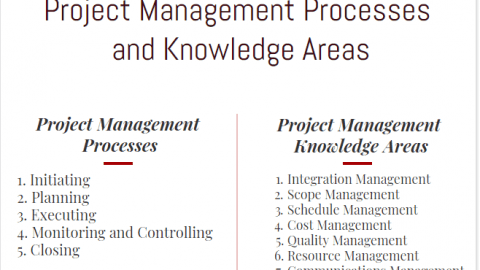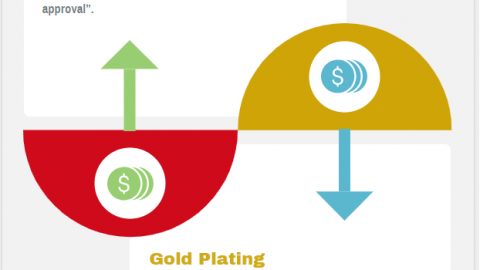Earned Value Management Tutorial
In this Earned Value Management tutorial, we will discuss the three metrics (Planned Value, Actual Cost and EV) of Earned Value Analysis and analyze an example for better understanding. Basically, Earned Value Management (EVM) is a project management technique for tracking the real project performance by incorporating scope, time and cost measurements. By combining these measurements, Earned Value Management provides correct forecasts for project progress and project cost management .
Table of Contents
No doubt, planning and cost control practices are vital for any projects success. In order to improve decision making within a project, a well-established performance measurement system must be established. The principles of Earned Value Management (EVM) have positive impacts on a project’s successful completion.
Basically, Earned Value Management (EVM) systems allow the project manager to answer the following three questions, as they relate to the project:
– Where are we now?
– Where have we been?
– Where are we going?
This article shortly explains earned value for more effective project management.
Earned Value Management (EVM) , Planned Value (PV), Actual Cost (AC)
Earned Value Management (EVM) is an approach of specifying project progress and comparing actual progress with planned progress and actual money spent. Although EVM was borned in United States Government programs for financial analysis, it became an important project management technique for all industries in recent years. It can be applicable to all projects with different level of complexity.
For better understanding, let’s review the example below.
Earned Value Management Example
A pipeline project has been approved for a duration of ten months. The budgeted cost of the project was 50 M $. The planned budget for the first 5 months was 30 M $. 5 months has been passed after the start of the project and the project team reported that they spent 30 M $. Many people think that 5 months passed and the budget was spent as planned so the project is on the track.
However, the provided information is not enough to make a decision. It is possible that the project can spend 30 M $ with completing %10 of the work which means that it will be over budget. We are using Earned Value Management technique to measure the actual work performed.
Basics of Earned Value Analysis
Planned Value (PV)
Planned Value (PV) defines how far along project work is supposed to be at any given time in the project schedule and cost estimate. It answers how much value you have planned to earn in a given time question.
For instance, it is planned to be spent $10000 to pour 100 m3 concrete for footings. The planned value for each m3 is $100. By definition, when that work is 50 m3 is poured, it will be worth $5000 to the project.
The planned value of the work is a time distributed data that can be obtained from the work schedule. Therefore a well-prepared work schedule with the help of Work Breakdown Structure provides categorized data for the planned value.
The critical path of the project determines the project’s duration and the completion date. If the critical path is realistic, the planned value and earned value calculations will be accurate. The planned value may be the allocation of the total budgeted cost of the project or the quantities such as manhour. It is an important metric of Earned Value Management.
Actual Cost (AC)
Actual Cost is the actual total cost spent for the completion of work. It is the total amount that has been spent.
For instance, it is planned to be spent $10000 to pour 100 m3 concrete for footings. The work is completed, 100 m3 is poured but $ 120000 is spent. The Actual Cost (AC) of the project is $ 120000.
Earned Value (EV)
Earned Value is the evaluation of the worth of the work performed to date which allows the project manager to quantify progress as a financial amount. If the project is stopped today, Earned Value will give you the value of work performed. The earned value stated directly is how much value you have earned on the project in a given time.
This system allows us to analyze all three measurements (planned value, actual cost, and earned value) on a single chart.
Planned Value, Actual Cost and Earned Value are the three metrics of the Earned Value Management.
Cost Graph
Let’s assume that we are managing a highway project and the project is 5 months along. Below graph shows budgeted cost versus actual cost situation.
This graph shows that our planned value (budgeted cost) is significantly more than actual costs and we appear to be underspending. But what can we say about the project’s performance? what about the actual work completed? Are we behind or above the schedule? Is it possible to finish this highway project on time? Unfortunately, this graph itself does not include sufficient information to answer these questions. We need more parameters for decision making.
Cost and Earned Value Graph
Let’s review the graph below for a better understanding of the Earned Value Management concept.
In order to see our projects real performance, we are adding the earned value parameter to this graph.
When we add the value of work performed to the graph we see that our actual schedule is not in a good situation. The earned value as of the 5th Month is significantly less than the budgeted cost so we are behind schedule.
And the earned value as of the 5′ th Month is less than the actual cost so we are over budget.
Summary
In this Earned Value Management Tutorial, we discuss the three metrics (Planned Value, Actual Cost and Earned Value) used for Earned Value Analysis. These elements can be used to develop a basic overview of your project status.
- Earned Value is the value of the work performed to date
- Planned Value is the planned value of the work
- Actual Cost is the actual amount spent for the completion of a task or a project
When you have these elements available, you can easily calculate the Earned Value of the project by using earned value analysis formulas. Thus, you will better understand the current status of your project and compare it with the planned progress. Note that there are many earned value management software available on the market (like Primavera P6). Using one of them may help you to perform these calculations in an effective way.
External References
[1] apm.org
See Also

I am a Civil Engineer in HES Consultancy Limited, experience as Director and Resident of Works and Technical, Financial and Administrative Project Audit. I have skills in the area of Procurement, Tenders and Contracting. I am PMP and PRINCE2 Certified. Monitoring and Control with the Earned Value Method.












